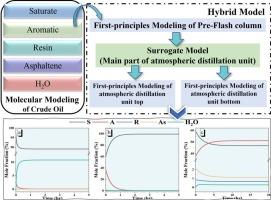常压蒸馏分离原油分子模型驱动混合模型的建立及产物成分分布动态预测研究
IF 4.3
2区 工程技术
Q2 ENGINEERING, CHEMICAL
引用次数: 0
摘要
蒸馏对原油分离至关重要,但由于多组分系统的热力学复杂性和强非线性,给建模带来了挑战。本文提出了一种动态混合建模方法来预测常压原油蒸馏过程中分离产物的分子组成随时间的分布。建立了包含152种真实分子的基准模型系统。通过整合预闪塔的动态第一性原理模型、常压塔顶段和底段的第一性原理模型以及主塔的代理模型,建立了常压精馏动态混合仿真框架。稳态条件下的验证表明混合模型与Aspen Plus仿真之间的一致性很强,所有产品部件的绝对误差保持在 ± 5 %以下。该模型对分子摩尔分数和汽液平衡常数具有较高的预测精度。在动态工况下,模型表现出鲁棒稳定性,重新建立稳态后,产品成分误差始终保持在 ± 5 %以内。超过90% %的分子含量预测显示绝对误差在- 0.5 %和1.0 %之间。预测的汽液平衡常数与参考值密切一致,数据点均匀分布在奇偶线上。实验结果证实了该混合模型能够捕捉原油蒸馏的动态特性,在分子水平的产物分布预测中具有较高的精度和实际工程适用性。本文章由计算机程序翻译,如有差异,请以英文原文为准。


Construction of molecular model-driven hybrid model for atmospheric distillation separation of crude oil and dynamic prediction study of product composition distribution
Distillation is crucial for crude oil separation but poses modeling challenges due to thermodynamic complexities and strong nonlinearities in multicomponent systems. This study proposes a dynamic hybrid modeling approach to predict the time-dependent molecular composition distribution of separated products in atmospheric crude oil distillation processes. A benchmark model system incorporating 152 real molecular species is developed. By integrating a dynamic first-principles model for the Pre-Flash column, first-principles models for the atmospheric column’s top and bottom sections, and a surrogate model for the main column, a dynamic hybrid simulation framework for atmospheric distillation is established. Validation under steady-state conditions demonstrates strong agreement between the hybrid model and Aspen Plus simulations, with absolute errors for all product components remaining below ± 5 %. The model achieves high predictive accuracy for molecular mole fractions and vapor–liquid equilibrium constants. Under dynamic operating conditions, the model demonstrates robust stability, with product component errors consistently maintained within ± 5 % upon re-establishing steady state. Over 90 % of molecular content predictions show absolute errors between −0.5 % and 1.0 %. Predicted vapor–liquid equilibrium constants align closely with reference values, as evidenced by data points distributed uniformly along the parity line. Experimental results confirm the hybrid model’s capability to capture dynamic characteristics of crude oil distillation, demonstrating both high accuracy in molecular-level product distribution predictions and practical engineering applicability.
求助全文
通过发布文献求助,成功后即可免费获取论文全文。
去求助
来源期刊

Chemical Engineering Science
工程技术-工程:化工
CiteScore
7.50
自引率
8.50%
发文量
1025
审稿时长
50 days
期刊介绍:
Chemical engineering enables the transformation of natural resources and energy into useful products for society. It draws on and applies natural sciences, mathematics and economics, and has developed fundamental engineering science that underpins the discipline.
Chemical Engineering Science (CES) has been publishing papers on the fundamentals of chemical engineering since 1951. CES is the platform where the most significant advances in the discipline have ever since been published. Chemical Engineering Science has accompanied and sustained chemical engineering through its development into the vibrant and broad scientific discipline it is today.
 求助内容:
求助内容: 应助结果提醒方式:
应助结果提醒方式:


